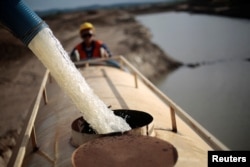A Brazilian official says water restrictions in Brasilia will end by December, when an expanded supply system will be completed.
United Nations officials say Brasilia, the capital of Brazil, is one of a growing number of cities with water shortages.
A U.N. report says water is in demand around the world as temperatures on Earth’s surface rise and demand grows along with populations.
The report was released this week at the World Water Forum in Brasilia. The conference has been described as the world’s largest water-related event.
Federal District Governor Rodrigo Rollemberg spoke at a panel discussion on Tuesday at the forum. He described water shortages as a worldwide problem.
“Here in Brasilia, it is no different,” he added.
The public water supply has less water because of low rainfall as well as fast and disorderly growth in Brasilia, which is part of the Federal District, Rollemberg said.
In January 2016, after three years of little rain, district officials began limiting how much water people could use.
The governments of the Federal District and the nearby state of Goias also gave $166 million to develop water infrastructure.
When work is completed, the expanded water supply will provide 2,800 liters of water per second to the Federal District’s 3 million people, and the same amount to Goias, said Rollemberg.
About 16 percent of Brazil’s 5,570 cities have water problems, the federal government said.
Demand around the world is expected to increase by nearly one-third by 2050. By then, 5 billion people could be left with poor access to water, the U.N. warned in its 2018 World Water Development Report.
To avoid such a crisis, U.N. officials called for “nature-based solutions” that use or copy natural processes that should be used to increase water availability. They said solutions could include changing farming methods so fields keep more moisture and nutrients, collecting rainwater, and protecting wetlands. The officials also proposed reestablishing floodplains and said that plants could be grown on housetops.
Such proposals will become more important as water industries grow.
By 2025, the worldwide demand for agriculture is expected to rise by about 60 percent, and energy production by around 80 percent, the report also said.
I'm Susan Shand.
Karla Mendes reported this story for the Reuters news agency. Susan Shand adapted her story for VOA Learning English. George Grow was the editor.
Write to us in the Comments Section or on our Facebook page.
________________________________________________________________
Words in This Story
infrastructure – n. the basic equipment and structures (such as roads and bridges) that are needed for an area to operate
per – prep. by the way of
access – n. permission or ability to enter; the right or ability to do something
moisture – adj. a small amount of a liquid (such as water) that makes something wet
floodplain – n. land that may be covered by floodwaters








